Contents
Imperial hazel grouse is a monocotyledonous flowering plant of the Liliaceae family and is popular in ornamental horticulture. In nature, this perennial is distributed from the northwestern part of India to the south of Turkey.
What does the royal grouse look like
Imperial hazel grouse is a bulbous herbaceous perennial. It looks like this:
- height up to 1,5 m;
- the shape of the bulbs is almost spherical, diameter up to 10 cm;
- leaves are collected in 4-8 pieces in 3-4 whorls;
- the shape of the plates is lanceolate;
- inflorescence-umbrella solitary, consists of 3-5 buds, located at the top of the shoot;
- length of a tripartite pistil up to 4,5 cm;
- a large number (up to 20) of bracts, located above the inflorescence;
- the shape of the perianth is bell-shaped, up to 5,5 cm long, the color is red, orange or yellow;
- the fruit is a winged box.
Flowering time depends on the particular variety. Usually the buds open in the second half of May. Flowering lasts approximately three weeks.

One of the features of the imperial hazel grouse bulbs is a pungent odor that repels some pests.
Varieties of imperial hazel grouse
The popularity of this perennial as a garden plant has led to the creation of many varieties of it. Their differences lie in the size, color of the buds.
Aurora
Variety Aurora (Aurora) grows up to 0,6-0,9 m. Its main characteristics:
- color brick-orange;
- leaves broadly lanceolate;
- flowers up to 4 cm in diameter, the length is the same or slightly less;
- on one plant six, less often – up to 12 buds.
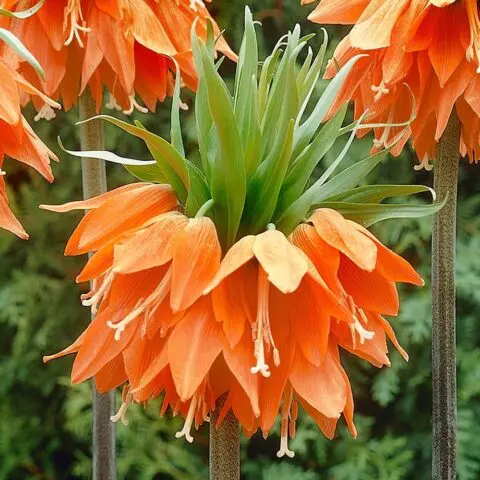
Aurora and most other varieties belong to the fifth zone of frost resistance and can withstand temperatures down to -28,9 ° C
rubra
Variety Rubra (Rubra) is distinguished by yellow or dark orange flowering. Plants reach a height of 0,8-1 m. The diameter of the flowers is 10 cm. There are usually 3-8 of them on one plant.
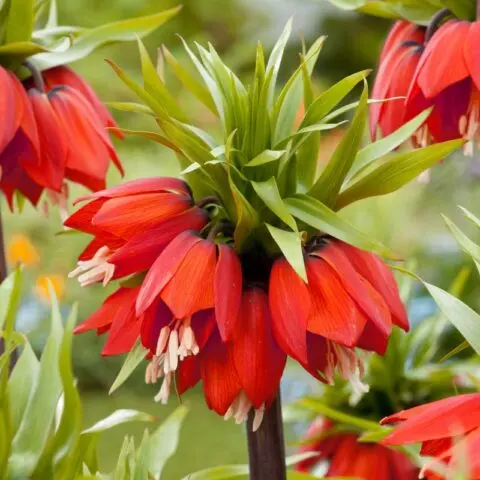
Rubra perennial blooms in May
Lutea
The Lutea variety has a golden yellowish bloom. The plant reaches a height of 0,9-1,2 m. The diameter of the flowers is 4 cm.
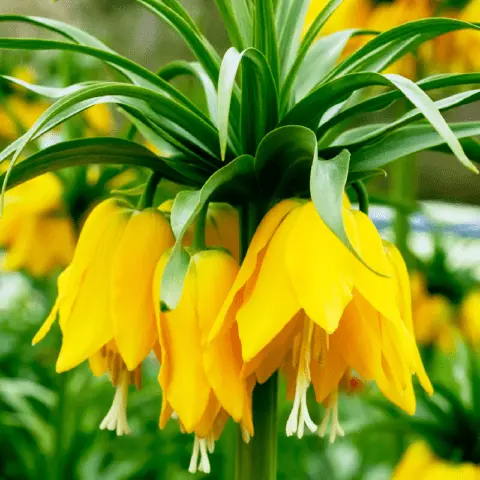
The flowering of the Lutea variety really resembles a golden crown – six buds form it
Strip Beauty
The Striped Beauty variety has yellow or darker flowers with longitudinal thin burgundy stripes. The perennial reaches a height of 0,9 m. In the inflorescence, usually up to seven, less often up to 11 buds.
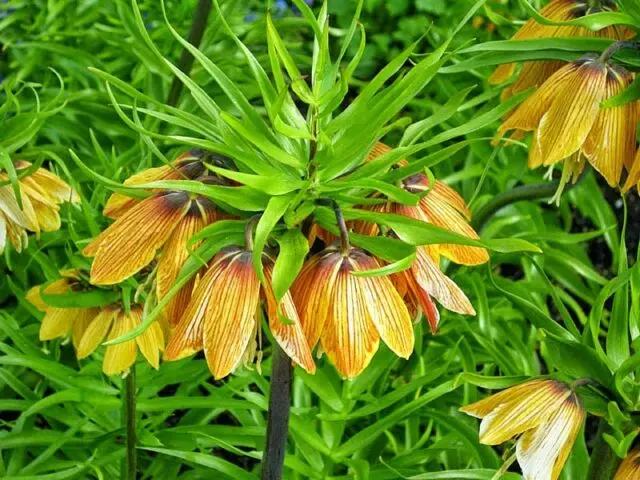
The diameter of the flowers of the Strip Beauty variety is 10 cm
Raddean
The Raddeana variety has straw-yellow flowers. Their diameter is 6 cm.
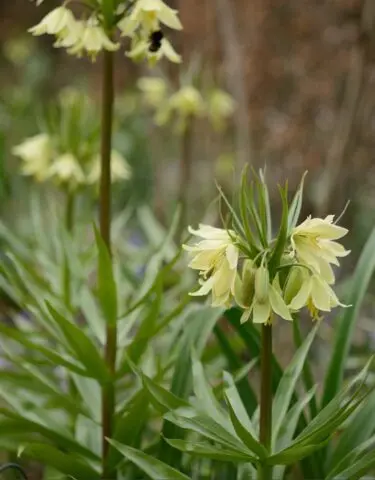
The Raddean variety is rather low – the perennial grows up to 0,4-0,6 m
How to plant an imperial hazel grouse
There is nothing difficult in growing and caring for imperial hazel grouse if the process is properly organized. Good growth and development of perennials, annual flowering, and winter hardiness depend on this.
When to plant imperial hazel grouse in open ground
The optimal time for planting royal hazel grouse is autumn. Work is planned for September-October. In this case, the perennial will bloom the very next year.
In the middle lane, it is better to plant during September so that the plant has time to take root. If done too late, the risk of perennial death is high.
In the south, imperial hazel grouse can be planted until mid-October. In the Urals and Siberia, it is better to finish all work at the end of August or early September.
When choosing the optimal time for autumn planting, the following factors are taken into account:
- night temperature not less than 5 °C;
- during the day, the thermometer shows from 10-15 ° C;
- before frost remains at least 3-4 weeks;
- soil temperature 15 cm from the surface 8-10 °C.
You can plant the imperial hazel grouse in the spring. In this case, it will bloom only next season.
Choice of location and bulbs
Properly planting a royal hazel grouse means choosing the right place for it. It must meet the following requirements:
- good lighting, partial shade is acceptable;
- lack of moisture stagnation;
- protection against strong wind, drafts;
- remoteness of groundwater;
- light and nutritious soil;
- loose soil;
- the optimum pH level is 6,5.
Provide drainage if necessary. It is recommended to add peat to the soil. If moisture stagnation occurs in the chosen place, then an embankment should be artificially created and hazel grouses should be planted on it. The same measure is resorted to if only a lowland is available for landing. Under such conditions, the underground part of the plant will rot.
If the soil is light, sandy, then it is necessary to add lowland peat or leaf humus. A bucket is enough for 1 m². Excessively heavy soil is balanced by the same amount of coarse sand.
Perennial bulbs for planting are bought or harvested independently. They must meet the following requirements;
- round-flattened form;
- diameter 8-10 cm, not less than 6 cm;
- no mechanical damage, cracks, stains;
- dry roots, scales are acceptable.
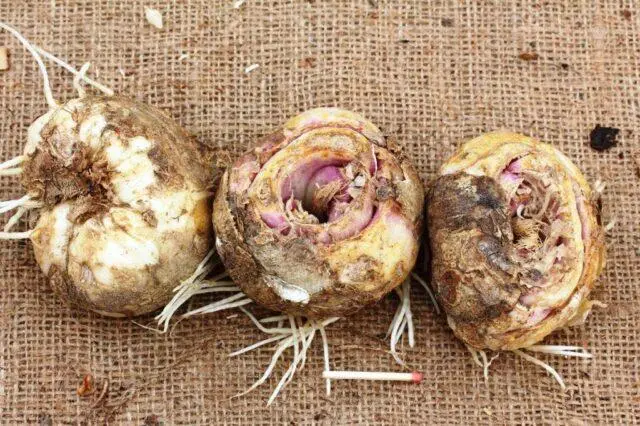
From last year’s peduncle, holes remain in the bulbs – they are through (the best option) or deaf
Rules of landing
Imperial hazel grouse should be planted on a previously prepared site. It is dug up to a depth of 0,5 m, cleaned of weeds and debris. Then fertilizers are applied at the rate of 1 m²:
- humus (compost) – 1 bucket;
- wood ash – 0,2 kg;
- superphosphate – 30 g;
- potassium chloride – 15 g.
After fertilization, the site is re-dug. Preparation for planting is also necessary for the bulbs. It concludes in such moments:
- elimination of dry roots, old scales;
- antifungal treatment – a strong solution of potassium permanganate (soaking for an hour), preparations such as Maxim summer resident, Fitosporin-M (use according to instructions);
- drying – the bulbs for this are removed in the shade.
When the site and planting material are properly prepared, proceed to the main part of the work:
- Loosen the soil.
- Level the surface.
- Dig holes. The depth should be oriented to the size of the bulbs, diameter 30-40 cm.
- Organize drainage from river sand at the bottom – take only coarse-grained material. A layer of 5 cm is enough.
- Sprinkle sand thinly with soil.
- Place the bulb in the hole, laying on its side.
- Sprinkle with coarse sand.
- Fill the hole with fertile soil.
- Liberally pour.
An important point is the planting depth of the imperial hazel grouse. It should be equal to three times the height of the bulb. For undersized varieties, the optimal depth is 10-13 cm, for tall ones – up to 20 cm. This distance should not be to the top of the bulb, but to its bottom.
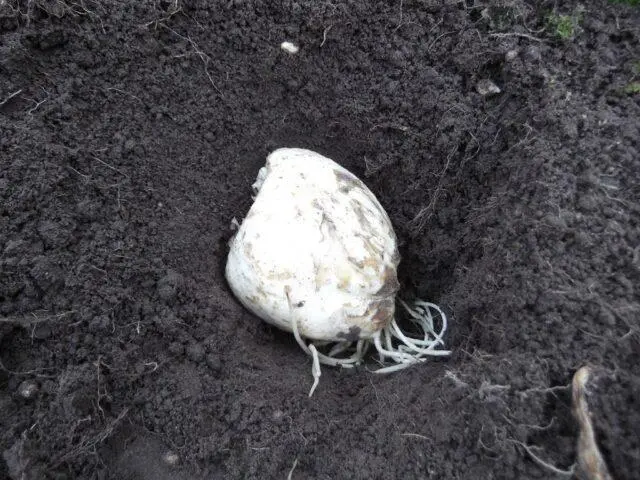
The bulbs are placed on their side so that in the future there is no excessive accumulation of water in the scales.
How to care for imperial hazel grouse
The agrotechnics of growing hazel grouse imperial implies comprehensive care. Perennial in this regard is quite unpretentious.
Watering
The imperial hazel grouse is drought-resistant. He needs special watering only during the dry season. It is enough to moisten the plantings twice a month.
After watering and heavy rainfall, it is recommended to weed the imperial hazel grouse. Mulching will retain moisture and slow down the growth of weeds.
Additional fertilizing
Feeding the imperial hazel grouse begins the next year after planting. Fertilizers are usually applied three times per season:
- spring – nitrogen compounds to stimulate the growth of green mass, application in April is recommended;
- budding phase – organic fertilizers, usually use an infusion of mullein or bird droppings or mulch the flower bed with compost;
- after flowering, a combination of potassium and phosphorus – it is convenient to use superphosphate, potassium sulfate.
Imperial hazel grouse is useful to feed during flowering. For this, it is good to use wood ash.
Preparation for winter
When the temperature in autumn becomes negative, plantings of imperial hazel grouse should be mulched. For this, the following options are suitable:
- spruce branches;
- dry foliage;
- straw;
- sawdust.
Mulch is removed in the spring immediately when the snow melts. Otherwise, a layer of material will block access to sunlight.
Mulch is also needed in winters with little snow. The optimal layer thickness is 25-30 cm. Such insulation is also necessary in regions where the temperature in winter can drop below the permissible limit (-28,9 ° C).
Trimming
If it is not planned to collect seeds of imperial hazel grouse, then after withering, flower stalks should be immediately cut off. This will support the decorativeness of the perennial, increase the flow of nutrients to the bulb.
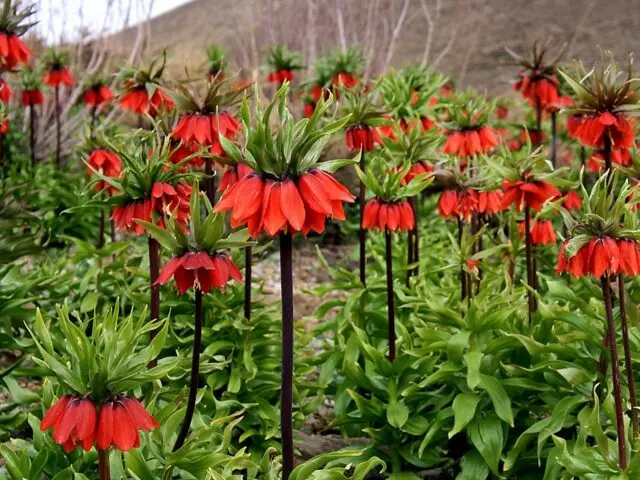
It is necessary to loosen the soil near imperial hazel grouses only when necessary.
Digging out
Imperial hazel grouse bulbs are recommended to be dug up annually after flowering. Without such a measure, the buds for next year may not bloom. They dig up bulbs of imperial hazel grouse and for the reason that remaining in the soil, they are more susceptible to rot and pest damage.
Harvesting is carried out after flowering, when the petals fall off, and the green parts of the perennial turn yellow. Another sign is the drying of the roots.
Usually bulbs of hazel grouse are dug up in June-July. They need to be stored not until next year, but only until autumn.
The bulbs are carefully undermined, stepping aside by 20-25 cm. It is better to use a pitchfork for this. They pull out the underground part, grabbing the remains of the stem.
The dug out bulbs are cleaned of the upper shell, treated with a fungicide or potassium permanganate and dried. Store them in a dry and well-ventilated place at temperatures above 25°C.
After digging up the bulbs, it is recommended to sift the earth at this place to remove plant debris. Be sure to inspect the soil for separated children. They can be grown.
When to transplant the imperial hazel grouse
Since the aerial part of the perennial dies off, and the bulbs are dug up for a while in the summer, it is convenient to combine such an event with a transplant of the imperial hazel grouse. To do this, you need to choose a place that meets all the requirements and prepare it in advance. The algorithm of work is exactly the same as for the initial planting of the bulbs.
How imperial hazel grouse breeds
Imperial hazel grouse can be propagated by seed or by dividing the bulbs. It depends on the option chosen how much planting material will be and when flowering will begin.
Bulbs
Gardeners usually propagate imperial hazel grouse by dividing the bulbs. They give children rarely and in small numbers. Bulbs divide almost every year. It is recommended to plant them immediately after purchase or digging without drying.
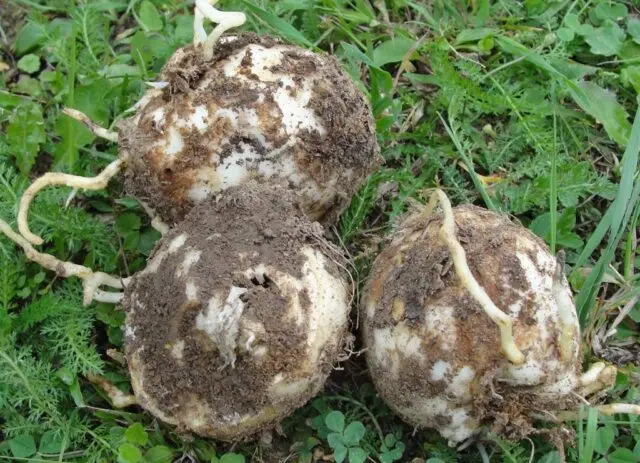
In order for baby bulbs to grow, digging is carried out not every year, but every other time
Seeds
This option means that flowering will have to wait 5-6 years. This method is usually used only for breeding on an industrial scale.
If you plan to collect seeds, then the flower stalks are not cut off after withering. Harvesting is carried out when the boxes are completely dry. It is recommended to sow seeds immediately after harvest. Close them up to a depth of 1 cm, leave 10 cm between rows. Seedlings are fed annually.
Diseases and pests
The imperial hazel grouse has good immunity, but its bulbs are prone to rot. It is usually found when digging up bulbs after flowering. The affected areas must be cleaned to healthy tissues and treated:
- iodine;
- zelenka;
- crushed charcoal;
- potassium permanganate solution;
- ash.
After processing, the bulb is dried. In autumn, it is better to plant it in a new place, and treat the soil in the former area with fungicides.
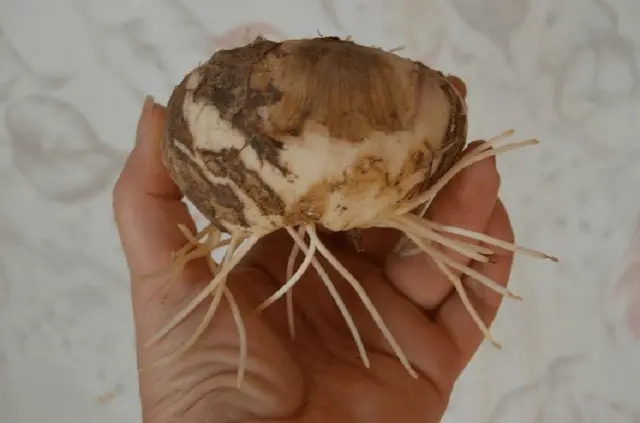
During storage, hazel grouse bulbs are regularly inspected – if the rot has reappeared, but these places are re-cleaned
Of the pests, the imperial hazel grouse can be annoyed by the lily beetle. The pest is harvested by hand and destroyed or insecticides are used:
- Commander;
- Talstar;
- Confidor;
- Inta-Vir;
- Tanrek;
- Karbofos;
- Kinmix.
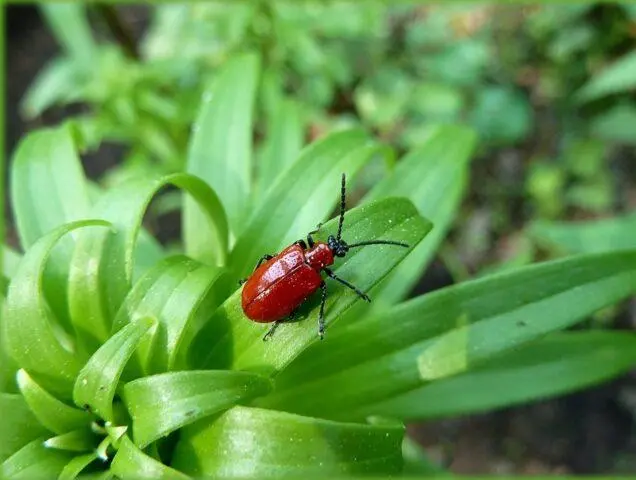
The lily beetle and its larvae eat various aerial parts of hazel grouse
Photo of imperial hazel grouse in landscape design
For a long time, imperial hazel grouse has been planted as an ornamental plant in the gardens of Europe and North America. The perennial is also popular in Our Country.
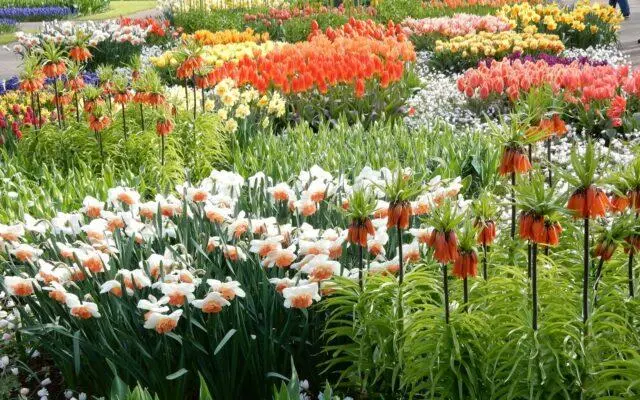
The imperial hazel grouse is usually used for mixed plantings, so that the neighbors close it after withering.
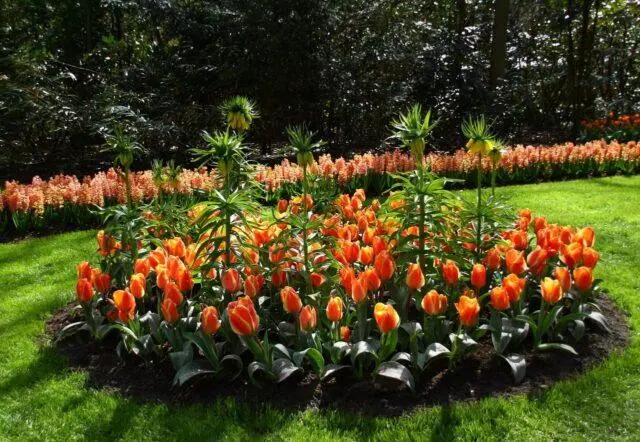
Imperial hazel grouses look beautiful surrounded by related tulips
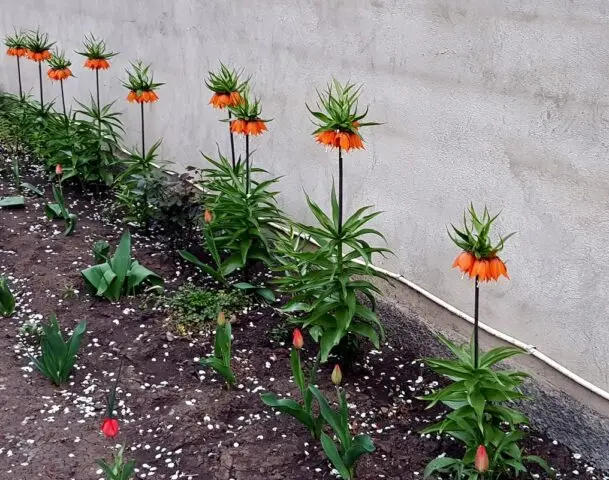
Imperial grouse can be planted in the background, against the backdrop of a fence or buildings
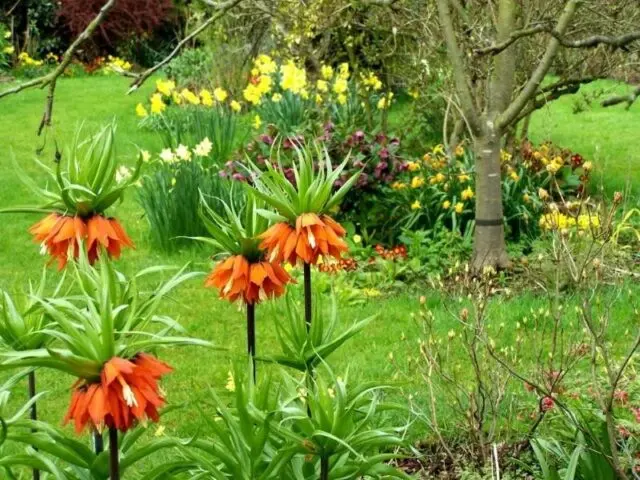
To create beautiful flower beds, imperial hazel grouses are planted with neighbors with consecutive or identical flowering periods.
Conclusion
Imperial hazel grouse is a rather unpretentious herbaceous perennial. This plant is often bred in gardens, many of its varieties have been bred, differing in height and color. Hazel grouse is propagated by seeds or bulbs, which are recommended to be dug up annually after flowering.









